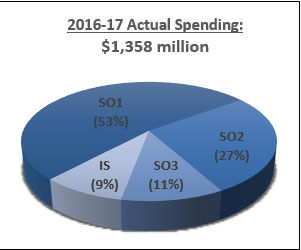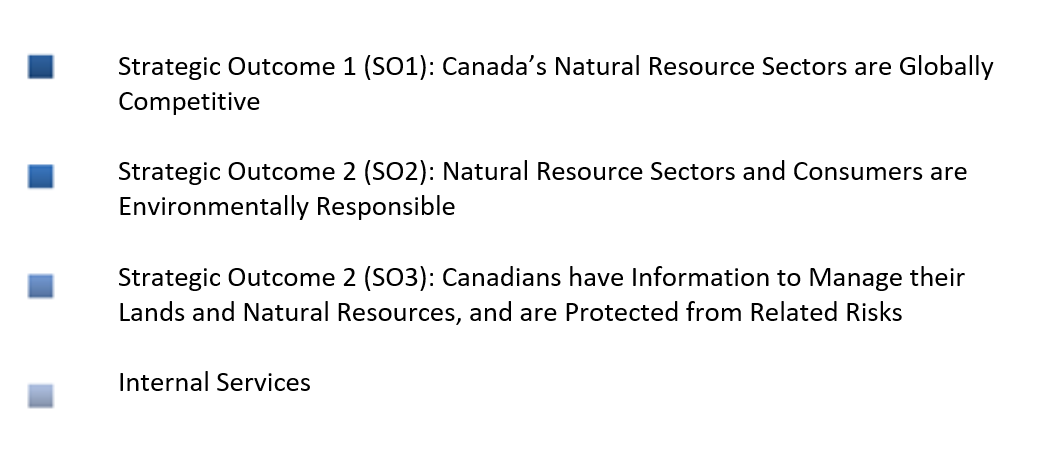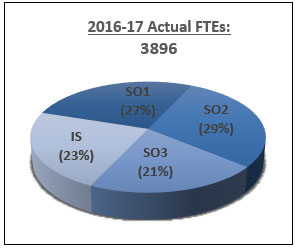Results at a glance
Natural Resources Canada (NRCan) promotes the sustainable development of Canada’s natural resources. Through our innovative research facilities, we conduct cutting-edge science in energy, forestry, minerals and metals, and earth observation. We also represent Canada internationally in meeting our global commitments to develop our resources sustainably.
In 2016–17, NRCan continued making progress on the Minister’s Mandate Letter Commitments, delivering results in the following areas:
- Advancing Canada’s interests in natural resources trade and investment: Through trade missions, ministerial dialogues and engagement with provinces and territories, NRCan promoted greater access to new markets, attracted investment and generated economic growth. The Department supported changes to building codes for mid-rise wood construction in Asia to help expand global market potential for Canada’s forest sector, building on Canada’s own success with tall wood construction. For example, a new Tall Wood Building Code was adopted in China in February 2017 that will increase the height of timber structures from three to five storeys. As well, four major pipelines were approved under the Interim Strategy for reviewing major resource projects. The Interim Strategy has also set the tone for extensive consultation with provinces and territories, particularly with Indigenous peoples, and enhanced environmental assessments. Under the Canadian Energy Strategy (CES), we worked with the provinces and territories to develop an energy action plan that will advance energy infrastructure, improve energy efficiency, expand new technology and innovation, and promote international collaboration.
- Supporting the climate change agenda: Canada strongly believes in doing its part to combat climate change, as evidenced in our signing the Paris Agreement in 2015. To fulfil our commitments at home, NRCan leads or co-leads 30 of the 54 actions under the Pan-Canadian Framework on Clean Growth and Climate Change (PCF) and provides expert support for 10 other actions. In 2016, Canada renewed its partnership with the United States and Mexico under the Leaders’ Statement on a North American Climate, Clean Energy and Environment Partnership. Under this agreement, the three countries agreed to align energy efficiency regulations, make energy infrastructure more resilient and reduce methane emissions. Federal participation in the CES positions our energy sector to drive immediate emission reductions and make the transformative changes required in the longer term to significantly improve energy efficiency, accelerate the transition to low-carbon sources of energy, promote cleaner electricity generation, and advance technology and innovation. We are doing the same in mining, bringing together stakeholders to identify and develop green technologies, processes and knowledge for sustainable mining under the Green Mining Initiative, and in forestry, where we are pursuing innovative technologies and new uses for forest fibre under the Investments in Forest Industry Transformation program.
- Enhancing development and implementation of clean technology and innovation: NRCan continues to invest in research, development and demonstration of innovative clean technologies to address the most pressing environmental issues. These investments are helping Canadian companies grow and position themselves as world leaders in the clean technology market. We supported Shell Canada’s Quest Carbon Capture and Storage Facility, a key project that successfully reached its target of capturing and storing over 1 million tons of carbon dioxide. The project continues to be one of the most successful large-scale carbon capture and storage demonstration projects in the world. The Department also developed innovative approaches in mining that reduce energy consumption and environmental impacts while producing economic benefits to industry. One such example is the use of bacteria instead of chemicals to recover nickel from mine waste and low-grade deposits. Leveraging Budget 2016, NRCan is also investing in technologies to reduce greenhouse gas (GHG) emissions in the oil and gas sector, and in new infrastructure such as vehicle charging stations for cleaner transportation. In 2016, we announced Canada’s international Mission Innovation commitment to double funding for clean energy and technology research and development, from $387 million to $775 million by 2020. To foster greater confidence for Canadians and more certainty for investors, NRCan is modernizing the National Energy Board, supporting the review of environmental assessments and developing an implementation strategy for major resource projects.
- Strengthening engagement and collaboration, including with Indigenous communities: Canadians should have a voice on matters that affect them most. Consultations were held with Indigenous communities that could be affected by the Interim Strategy for resource development, particularly the Trans Mountain Expansion and Line 3 Replacement pipeline projects. For the first time ever, we created Indigenous Advisory and Monitoring Committees to ensure direct involvement at each stage of project development and support our commitment to a renewed relationship with Indigenous peoples. NRCan met with over 1,000 Canadians in 10 cities, including with Indigenous groups, to hear their views on modernizing the National Energy Board. We also considered the comments made in more than 200 emails. As well, we supported economic development for Indigenous peoples by promoting greater participation in the forest sector through the Indigenous Forestry Initiatives program. The program facilitated the allocation of harvest wood, installation of energy-efficient heat sources and participation in the negotiation of a power purchase agreement for the supply of power and the creation of new jobs for Indigenous communities.
- Making world-class science available to Canadians: NRCan is a science department and our work provides hard data for evidence-based decision-making. In the spirit of transparency, accountability and engagement with Canadians, we have made information publicly available through the Open Government initiative. Tools such as the Federal Geospatial Platform provide publicly available information, including socioeconomic and environmental data, to Canadians through the Open Maps portal. We developed ways to help Canadian businesses minimize negative environmental impacts while decreasing costs, for example, through a process for extracting tight oil by using carbon dioxide waste. We tested new tools and innovative new products for eventual use by industry, including energy-efficient building materials and climate modelling tools. We assessed Canada’s natural resource potential on land and offshore to make balanced decisions about sustainable development and environmental protection, and we provided better data for potential investors through geoscience surveys and forest inventories. We updated the 2016 Canadian Wildland Fire Strategy to assist with the implementation of wildland fire preparedness and response, and we provided extensive support, including detailed satellite imagery, to equip decision-makers and first responders to take timely and informed action during the Fort McMurray forest fires in 2016.

Text version
Results Highlights
Actual Spending 2016-17
Total : $ 1,358 million
| Strategic Outcomes | Percentage of Actual Spending |
|---|---|
| S0 1: Canada’s Natural Resource Sectors are Globally Competitive | 53% |
| SO 2: Natural Resource Sectors and Consumers are Environmentally Responsible | 27% |
| SO 3: Canadians have Information to Manage their Lands and Natural Resources, and are Protected from Related Risks | 11% |
| Internal Services | 9% |

Text version
Strategic Outcomes
Strategic Outcome 1 (SO1): Canada’s Natural Resource Sectors Globally Competitive
Strategic Outcome 2 (SO2): Natural Resource Sectors and Consumers are Environmentally Responsible
Strategic Outcome 3 (SO3): Canadians have information to Manage their Lands and Natural Resources, and are Protected from Related Risks
Internal Services

Text version
Actual FTEs 2016-17
Total : 3896
| Strategic Outcomes | Percentage of FTEs |
|---|---|
| S0 1: Canada’s Natural Resource Sectors are Globally Competitive | 27% |
| SO 2: Natural Resource Sectors and Consumers are Environmentally Responsible | 29% |
| SO 3: Canadians have Information to Manage their Lands and Natural Resources, and are Protected from Related Risks | 21% |
| Internal Services | 23% |
For more information on the Department’s plans, priorities and results achieved, see the “Results: what we achieved” section of this report.
Page details
- Date modified: